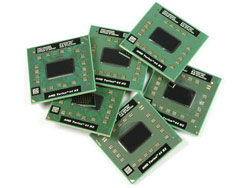In trying to convince users to switch from XP to Windows 7 as soon as possible, Microsoft has recently announced that the operating system will come with an XP Mode add-on (provided free of charge for Windows 7 Professional, Windows Enterprise, and Windows Ultimate). While it is true that Windows XP Mode provides a viable means of running older productivity apps on a PC running Windows 7, it is also true that not all processors will be able to handle this task.
“Windows XP Mode is specifically designed to help small businesses move to Windows 7. Windows XP Mode provides you with the flexibility to run many older productivity applications on a Windows 7 based PC. All you need to do is to install suitable applications directly in Windows XP Mode which is a virtual Windows XP environment running under Windows Virtual PC. The applications will be published to the Windows 7 desktop and then you can run them directly from Windows 7” explained Director of Windows Enterprise and Virtualization Strategy, Scott Woodgate, at the time.
Windows Virtual PC requires hardware-assisted virtualization technology (VT) support, meaning that not all processors will be able to handle it. Take Intel processors for example; according to ZDNet’s Ed Bott, not all will be able to support Windows Virtual PC:
“Desktop CPUs
Core 2 Duo
E4300/4400/4500/4600/4700 NO
E6300/6320/6400/6420/6540/6550 YES
E6600/6700/6750/6850 YES
E7200/7300/7400/7500 NO
E8190 NO
E8200/8300/8400/8500/8600 YES
Core 2 Extreme
QX6700/6800/6850 YES
QX9650/9770/9775 YES
X6800 YES
Core 2 Quad
Q6600/6700 YES
Q8200/8200S/8300/8400/8400S NO
Q9300/9400/9400S YES
Q9450/9550/9550S/9650 YES
Core i7/Core i7 Extreme
I7-920/940 YES
I7-965 YES
Pentium D/Pentium EE
805/820/830/840 NO
915/925/935/945 NO
920/930/940/950/960 YES
955/965 YES
Pentium for Desktop
E2140/2160/2180/2200/2220 NO
E5200/5300/5400 NO
Mobile CPU products
Core 2 Duo Mobile
L7200/7300/7400/7500 YES
P7350/7450 NO
P7370 YES
P8400/8600/8700/9500/9600 YES
SL9300/9400/9600 YES
SP9300/9400/9600 YES
SU9300/9400/9600 YES
T5200/5250/5270/5300/5450/5470 NO
T5500/5600 YES
T5550/5670/5750/5800/5850/5870/5900 NO
T6400/6570 NO
T7100/7200/7250/7300/7400 YES
T7500/7600/7700/7800 YES
T8100/8300 YES
T9300/9400/9500/9550/9600/9800 YES
U7500/U7600 YES
Core 2 Extreme Mobile
QX9300 YES
X7800/7900 YES
X9000/9100 YES
Core 2 Quad Mobile
Q9000 YES
Q9100 NO
Core 2 Solo
SU3300/3500 YES
U2100/2200 YES
Core Duo
L2300/2400/2500 YES
T2050/2250 NO
T2300/2400/2500/2600/2700 YES
T2300E/2350/2450 NO
U2400/2500 YES
Core Solo
T1300/1400 YES
T1350 NO
U1300/1400/1500 YES”
One simple way to check if a processor will be able to support Windows Virtual PC and will be able to run Windows XP Mode, is to look at the name. If the name has VT (virtualization technology) in it, then you should be ok; in Intel’s case you should see Intel VT, while in AMD’s case it is AMD-V. An even simpler method is by using specialized software – SecurAble for example comes free of charge, requires no installation, and will inform you if your CPU supports hardware virtualization.
“Windows XP Mode is specifically designed to help small businesses move to Windows 7. Windows XP Mode provides you with the flexibility to run many older productivity applications on a Windows 7 based PC. All you need to do is to install suitable applications directly in Windows XP Mode which is a virtual Windows XP environment running under Windows Virtual PC. The applications will be published to the Windows 7 desktop and then you can run them directly from Windows 7” explained Director of Windows Enterprise and Virtualization Strategy, Scott Woodgate, at the time.
Windows Virtual PC requires hardware-assisted virtualization technology (VT) support, meaning that not all processors will be able to handle it. Take Intel processors for example; according to ZDNet’s Ed Bott, not all will be able to support Windows Virtual PC:
“Desktop CPUs
Core 2 Duo
E4300/4400/4500/4600/4700 NO
E6300/6320/6400/6420/6540/6550 YES
E6600/6700/6750/6850 YES
E7200/7300/7400/7500 NO
E8190 NO
E8200/8300/8400/8500/8600 YES
Core 2 Extreme
QX6700/6800/6850 YES
QX9650/9770/9775 YES
X6800 YES
Core 2 Quad
Q6600/6700 YES
Q8200/8200S/8300/8400/8400S NO
Q9300/9400/9400S YES
Q9450/9550/9550S/9650 YES
Core i7/Core i7 Extreme
I7-920/940 YES
I7-965 YES
Pentium D/Pentium EE
805/820/830/840 NO
915/925/935/945 NO
920/930/940/950/960 YES
955/965 YES
Pentium for Desktop
E2140/2160/2180/2200/2220 NO
E5200/5300/5400 NO
Mobile CPU products
Core 2 Duo Mobile
L7200/7300/7400/7500 YES
P7350/7450 NO
P7370 YES
P8400/8600/8700/9500/9600 YES
SL9300/9400/9600 YES
SP9300/9400/9600 YES
SU9300/9400/9600 YES
T5200/5250/5270/5300/5450/5470 NO
T5500/5600 YES
T5550/5670/5750/5800/5850/5870/5900 NO
T6400/6570 NO
T7100/7200/7250/7300/7400 YES
T7500/7600/7700/7800 YES
T8100/8300 YES
T9300/9400/9500/9550/9600/9800 YES
U7500/U7600 YES
Core 2 Extreme Mobile
QX9300 YES
X7800/7900 YES
X9000/9100 YES
Core 2 Quad Mobile
Q9000 YES
Q9100 NO
Core 2 Solo
SU3300/3500 YES
U2100/2200 YES
Core Duo
L2300/2400/2500 YES
T2050/2250 NO
T2300/2400/2500/2600/2700 YES
T2300E/2350/2450 NO
U2400/2500 YES
Core Solo
T1300/1400 YES
T1350 NO
U1300/1400/1500 YES”
One simple way to check if a processor will be able to support Windows Virtual PC and will be able to run Windows XP Mode, is to look at the name. If the name has VT (virtualization technology) in it, then you should be ok; in Intel’s case you should see Intel VT, while in AMD’s case it is AMD-V. An even simpler method is by using specialized software – SecurAble for example comes free of charge, requires no installation, and will inform you if your CPU supports hardware virtualization.

























